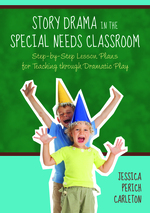 Introducing drama to the learning experience is an especially effective approach for children with special educational needs, including those with autism spectrum disorders.
Introducing drama to the learning experience is an especially effective approach for children with special educational needs, including those with autism spectrum disorders.
In her new book Story Drama in the Special Needs Classroom, theatre teacher Jessica Perich Carleton offers teachers from all disciplines an array of simple and easy-to-implement theatrical techniques that will enhance students’ learning and encourage artistic expression.
Here, Jessica explains why this approach is so effective, and how any teacher can apply it confidently and successfully.
Please tell us a bit about your background, and what motivated you to write this book.
I was working for a wonderful organization called VSA Arts of New Jersey (a John F. Kennedy Center affiliate in Washington D.C.) creating and organizing programming for all abilities and all artistic mediums. New Jersey has one of the highest rates of autism in the U.S., and so the majority or programming was focused on autism and the arts. When I taught one of the programs I assumed there were resources for teachers and/or artists detailing how theatre could be used with elementary school aged children (5-11) with autism. I was wrong. So I felt it was necessary to create a book that gives teachers – regardless of experience – practical tools and completed dramas and lesson plans to start creating drama in the classroom.
Why is this approach especially effective for children with Autism Spectrum Disorders (ASDs) and other special needs?
The formula (called the Dramatic Formula) in the book presents each step with a specific skill that the students need in order to succeed in the drama, while at the same time balancing the level of stimulation for the students so they can focus on each section. Structure and balance of stimulation are the two main factors which give this book success. These two elements allow the students to succeed in a safe and nurturing environment.
How should this book be used? Can you give some examples of successful applications from your experience?
The book is very structured but at the same time it gives the teacher enormous flexibility. For the first-time facilitator, I strongly suggest following the plan as written and following the steps in the pre-written story dramas at the end of the book. This will ensure teacher and student success, perhaps in a style of learning that may be new and different.
When I implemented the steps in the Dramatic Formula with elementary school aged students (5-11) with severe autism I followed the same Dramatic Formula every week. It never changed and the students weren’t bored with it or didn’t think that it was stupid because we did it last week. I believe they looked forward to tackling each task. Because even though the structure of the lesson was the same, the activities we played within that structure changed so it was never boring. And even in a short time, there was definite improvement; students became more confident and started to say the lines and initiate the next plot point in the story drama.
What are the most important factors to bear in mind when choosing a children’s story to convert to a story drama?
Children’s stories are one of the greatest resources a teacher can have in the classroom. When choosing a children’s story in order to transform it into a story drama, the story line of the book should possess active and strong language. The characters in the story should be doing things, going places, fulfilling tasks. The more active the story, the easier it will be to transform it into a story drama and the more engaging it will be for the students. Children’s books where the storyline is more narrative are difficult to convert into a story drama.
What advice would you give a teacher who feels uncomfortable ‘acting’ in front of his or her class?
Take baby steps! Just like the students in the classroom no one is going to be successful at performing Hamlet if we haven’t learned how to deliver a line or to create character strategies and tactics to achieve his/her goals. The book breaks down how to “act” in front of the classroom through several Teacher Theatrics. It outlines for the teacher the most simple and fool-proof execution of the technique as well as more advanced options. Teachers can choose where on the scale they feel the most comfortable. What is most important is that the teacher feels comfortable and confident because the class will mirror her/his behavior – hence why there are several entry points for each Teacher Theatrics to ensure success. When teachers have the opportunity to learn through play it is the most rewarding experience for everyone. Students and teachers experience seeing each other from an entirely different perspective where skills and talents may have been overlooked in the past.
Copyright © Jessica Kingsley Publishers 2011.